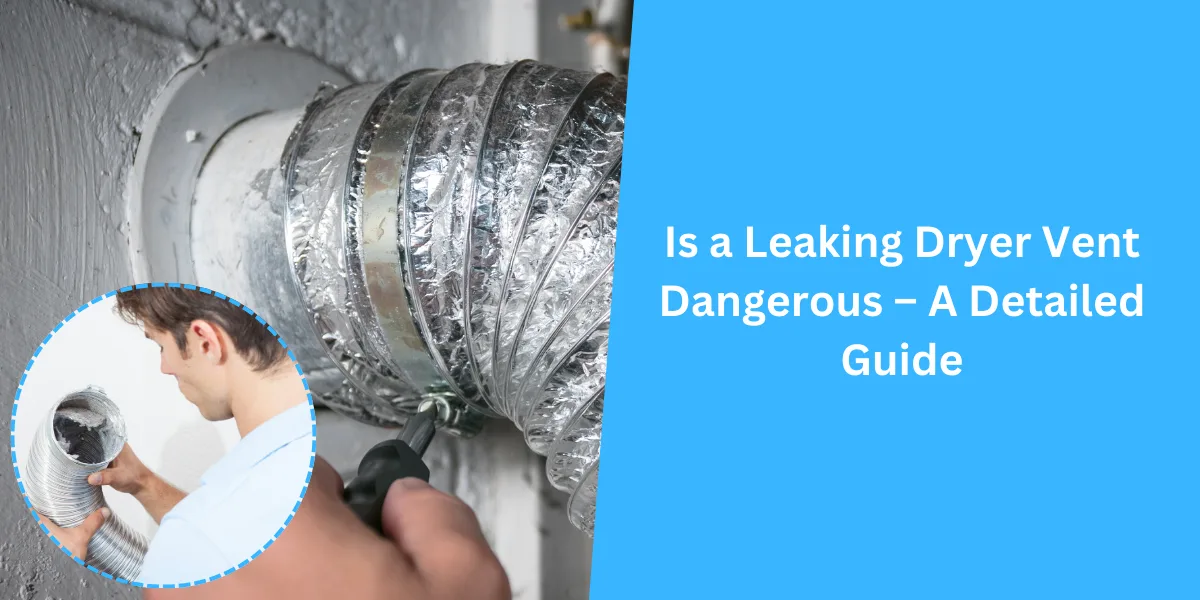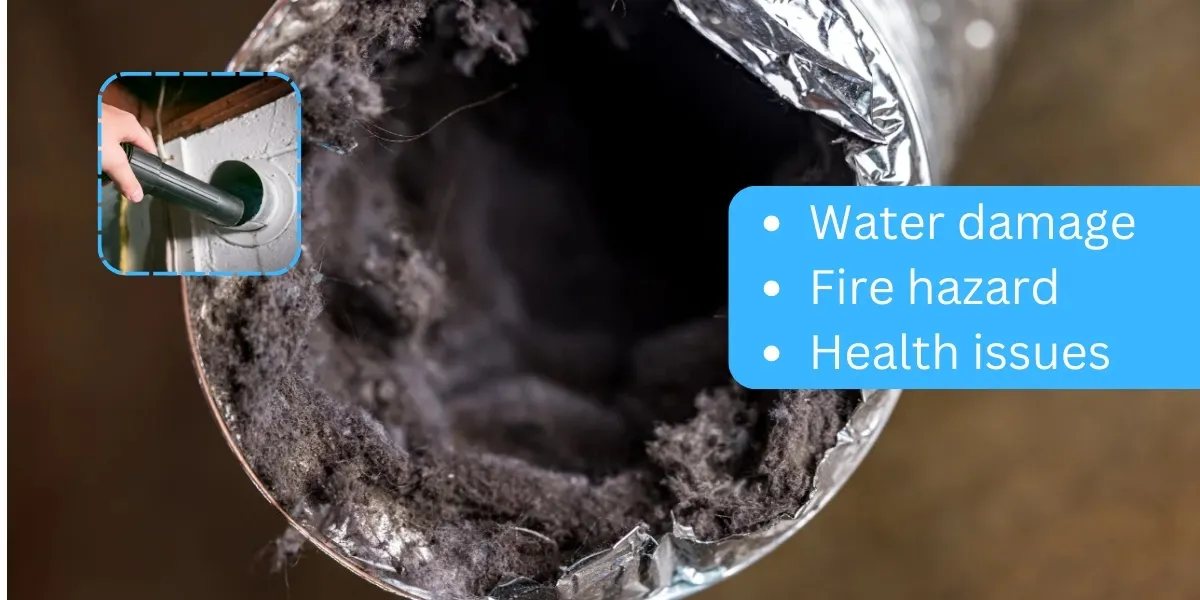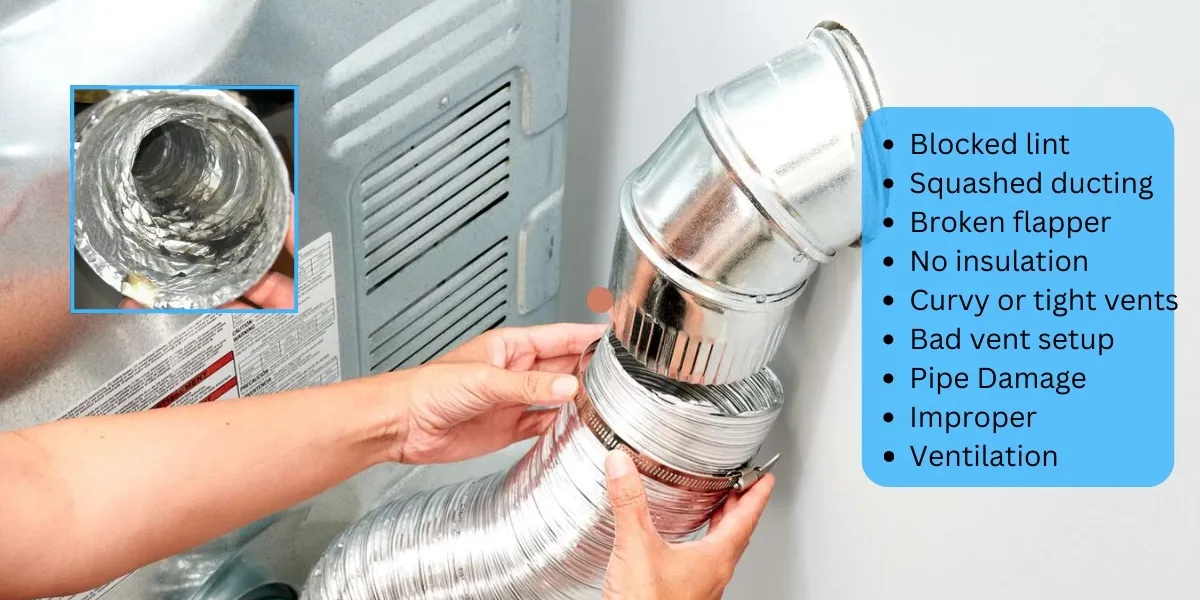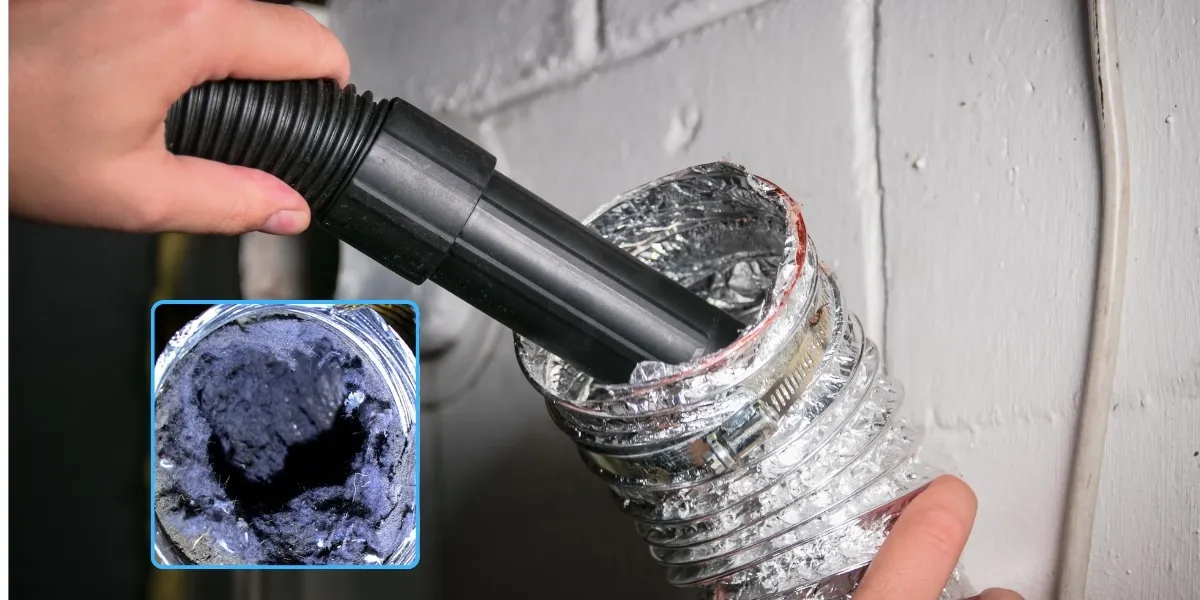
Imagine this: you just finished a sweaty workout, tossed your gym clothes in the dryer, and hit start. But instead of the usual whirring, you hear a dripping sound. You peek behind the dryer and discover… water! Is a leaky dryer vent dangerous?
In short, yes, a leaky dryer vent can be dangerous for your home and your health because it can lead to mold growth, fire hazards, water damage, and more. Immediate action is important to prevent further issues.
This detailed guide will explore why a leaking dryer vent is dangerous and what you can do about it.
What’s the Deal with a Leaking Dryer Vent?
First, let’s discuss what a dryer vent does. You know that hot, moist air that your dryer blows out? Well, the dryer vent is like a little tunnel that helps that air escape outside. It’s super important because if that hot, damp air stays trapped inside your house, it can cause all sorts of problems like mold and mildew.
But when your dryer vent starts leaking, it’s like having a tiny hole in that tunnel. Instead of all the air going outside where it’s supposed to, some of it sneaks back into your home. And where there’s moisture, there’s potential for trouble.
So, Is a Leaking Dryer Vent Dangerous? Why?
Picture this: you’re out for a walk on a sunny day, and you come across a little crack in the sidewalk. It doesn’t seem like much, but if enough water seeps in and freezes overnight, that crack could turn into a big, dangerous hole.
It’s kind of the same with your dryer vent. Even though it might start as just a small leak, if it’s not fixed, it can lead to bigger issues down the road. That extra moisture in your home can create the perfect environment for mold and mildew to grow. And nobody wants that, right?
Potential Problems You Might Face

Here’s why a leaking dryer vent can cause big problems for you and your home:
- Water damage: The air coming out of your dryer is really humid because it’s getting rid of moisture from your wet clothes. If the dryer vent doesn’t go outside, all the moisture ends up inside your house. It can go straight into the laundry room or even seep into your walls or attic if there’s a leak. Too much humidity over time can cause mold and damage from the moisture.
- Fire hazard: If your laundry area is covered in dust and lint due to a leaking dryer vent, it increases the risk of a fire. Dryer lint is highly flammable, and dryer fires can be really dangerous.
- Health issues: Besides the mold that can grow from the extra humidity, the air leaking from your dryer isn’t healthy to breathe. It’s full of volatile organic compounds (VOCs) that can lead to breathing problems and other health issues.
How to Tell If Dryer Vent is Leaking Water
Here are some signs to watch out for:
- Visible water leaks: This is a clear giveaway, like finding a puddle behind your dryer.
- Longer drying times: If your clothes are taking forever to dry, it could be a sign of clogged vents and trapped moisture.
- Lint buildup around the vent outlet: This is a telltale sign that lint is escaping the vent, which means moisture probably is, too.
Causes of Dryer Vent Leaks

Dryer vents don’t hold water like plumbing pipes, but they do carry humidity and water vapor from your wet laundry to the outside of your house. If water is leaking from your dryer vent, it means there’s condensation inside the duct, and you need to do something about it.
Here are some reasons why condensation might happen and cause leaks:
- Blocked lint: This happens when lint builds up and stops water vapor from escaping, which can be a big fire hazard.
- Squashed ducting: When the flexible duct behind the dryer gets squeezed, airflow slows down, creating a place for lint and water to get stuck, which is risky.
- Broken flapper: If the flap at the end of the vent isn’t working, humid air can’t get out, leaving water droplets in the duct.
- No insulation: If the vent goes through cold areas like the attic or near cold stuff like water pipes, the hot air inside can turn into water when it hits the cold walls.
- Curvy or tight vents: If the vent has lots of bends, it slows down airflow, letting lint pile up and water collect.
- Bad vent setup: If the vent isn’t put together or installed right, like with tape inside or screws sticking out, lint can get stuck and cause water problems.
- Pipe Damage: Holes or cracks in the vent pipe can cause leaks as hot air and moisture escape into your home.
- Improper Ventilation: If the vent doesn’t lead outside, like if it goes into an attic, moisture can build up, causing leaks.
Visit our informative blog to learn, “Are indoor dryer vents safe?”
Don’t Panic, Take Action!
If you suspect water dripping from the dryer vent, the good news is you can take action! Here’s how to fix the water in the dryer vent:

Inspect Your Pipes
To start cleaning your dryer vent, check your ducts to see where the clogs are. Take off the duct that connects your dryer to the one in your wall, but be careful not to detach it completely or damage it. Since the vent gets hot when the dryer is on, wait about half an hour after using it before touching it or working on it.
Look for mold near your dryer, which could mean there’s a leak in the vent. Also, check for any water damage in the area. If you have a lot of water damage, you might be able to get help from your insurance.
Homeowner’s insurance usually covers water damage, but it depends on your policy and provider if a dryer vent leak is included, as it could be seen as neglect.
Clean Your Dryer Pipes
According to the U.S. Fire Administration, not cleaning (31%) was the biggest reason why clothes dryer fires started in homes from 2018 to 2020. So, to clean your dryer pipes, start by checking for blockages. Take out the duct and look inside for lint, fabric bits, or other stuff that’s blocking the airflow and causing leaks.
Use a vacuum to suck up all the gunk, but be gentle when shaking the duct to make sure everything comes out. Doing this regularly keeps the airflow safe and can even stop fires from happening.
Seal Any Holes You’ve Found
When you’re inspecting your pipes or fixing them, keep an eye out for any holes where water might be leaking out, or pests might be getting in. Before you finish up, seal these holes with aluminum tape to stop outside dirt from getting into the duct and causing problems.
Visit our insightful blog to get the right answer to your question, “How often should condo dryer vents be cleaned?”
Shorten Your Dryer Vent Duct
If your dryer vent is too long and has lots of bends, it’s more likely to trap lint and fabric. One solution is to make it shorter by cutting it to the right length. You might need a professional to help you install the vent after you shorten it.
Make sure there’s enough length so you can pull your dryer about a foot away from the wall if needed, but not so much that the route from your dryer to the outside is too twisted.
You can cut the vent with a utility knife or scissors.
Insulate Your Pipes
If you live where it gets really cold, your pipes might leak more often. That’s because the cold outside makes a big difference from the hot air in the pipes. When the dryer’s hot air meets the chilly outside, water can start to drip off the pipes.
To stop this, wrap your vents with fiberglass insulation. It’s easier if your vent is a solid pipe instead of a flexible one with bends. (Solid pipes also tend to get less blocked with lint.)
Make sure to insulate all parts of the pipe, not just the ones near the cold air.
Create Space Between Pipes
Dryer pipe leaks can happen if the pipe is too close to water sources or condensation. Surprisingly, air conditioner pipes or cold water pipes touching or leaning on dryer vents can cause leaks because of humidity.
Try to create some space between the dryer vent and other pipes—ideally six inches or more. Secure them in their new spots to prevent them from moving back.
Replace Old Parts
All parts of the pipe need to work right for the dryer air to go out properly, including flappers that open and close. These parts are really important. If they don’t work, water from outside, like rain, sprinklers, or even a garden hose, can get in.
Check your dryer vent and flapper to make sure they work right, and replace any broken or missing parts as soon as you can.
Visit our informative blog to learn what happens if you can’t vent your dryer outside.
Contact a Pro
Choose Steam Express for professional dryer vent cleaning in Houston, Texas. Our licensed and insured team guarantees thorough cleaning to enhance dryer performance and safety. Call 832-479-6562 to book now and enjoy a special discount.
Our eco-friendly process removes lint and debris, ensuring a safer and more efficient dryer. Don’t wait—schedule your cleaning today for peace of mind and quicker drying times.
Wrapping Up
To sum it up, if your dryer vent is leaking, it’s a big problem for your home and health. It can cause water damage and even start a fire. You need to fix any leaks right away to stop things from getting worse. So, is a leaking dryer vent dangerous? Absolutely. Make sure to act fast to keep your dryer vent safe and working well.
FAQs
Rainwater is coming in through the dryer vent. What to do now?
Turn off your dryer immediately and call a professional to inspect and repair the dryer vent to prevent water damage and mold growth.
What is a dryer vent condensation leak?
A dryer vent condensation leak occurs when moisture from the dryer’s hot air condenses inside the vent and causes water to leak out.
Is it normal for a dryer vent to be wet?
If you take apart your dryer vent and touch the inside right after drying clothes, it might feel damp and warm. That’s okay because the vent just finished getting rid of the humidity from your laundry. But if you see water droplets in the vent all the time, it means there’s a problem with how the machine’s air is flowing. You should call a professional to fix it right away.
How often should a dryer vent be cleaned?
Ideally, clean your dryer vent yearly, but if you do laundry often or have pets, consider cleaning it every 6 months to prevent fires and maintain efficiency.

